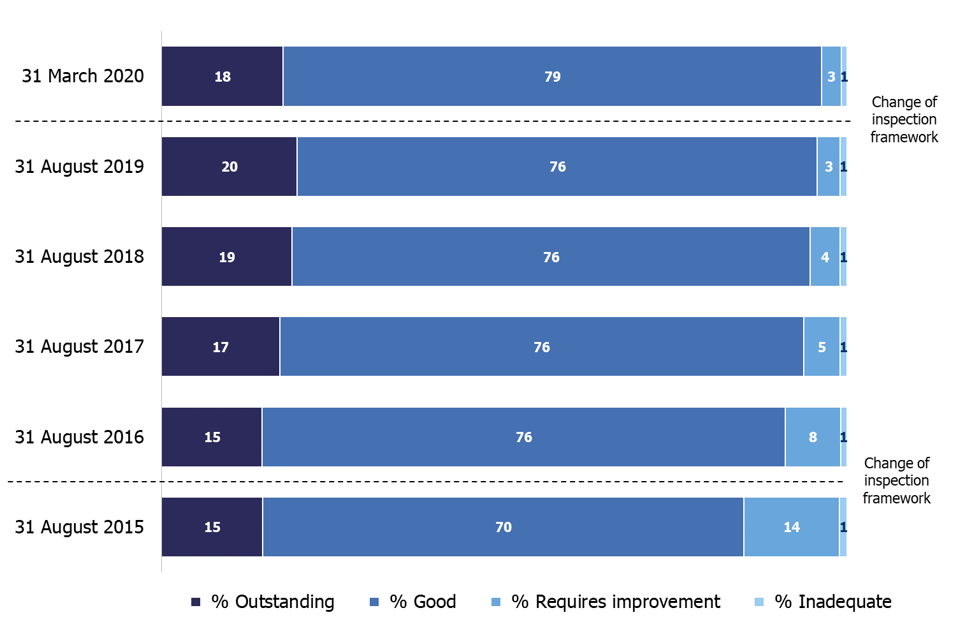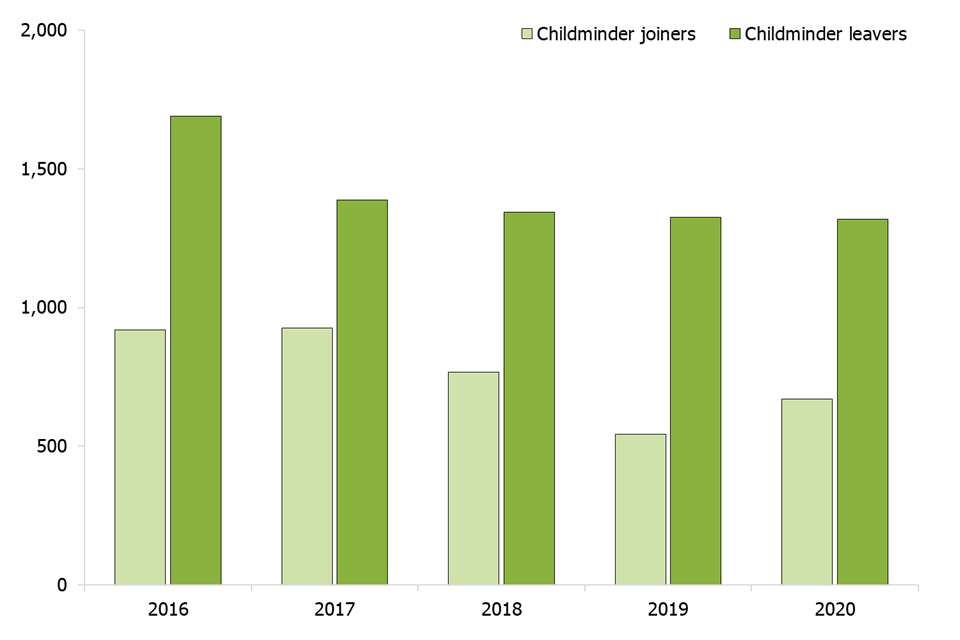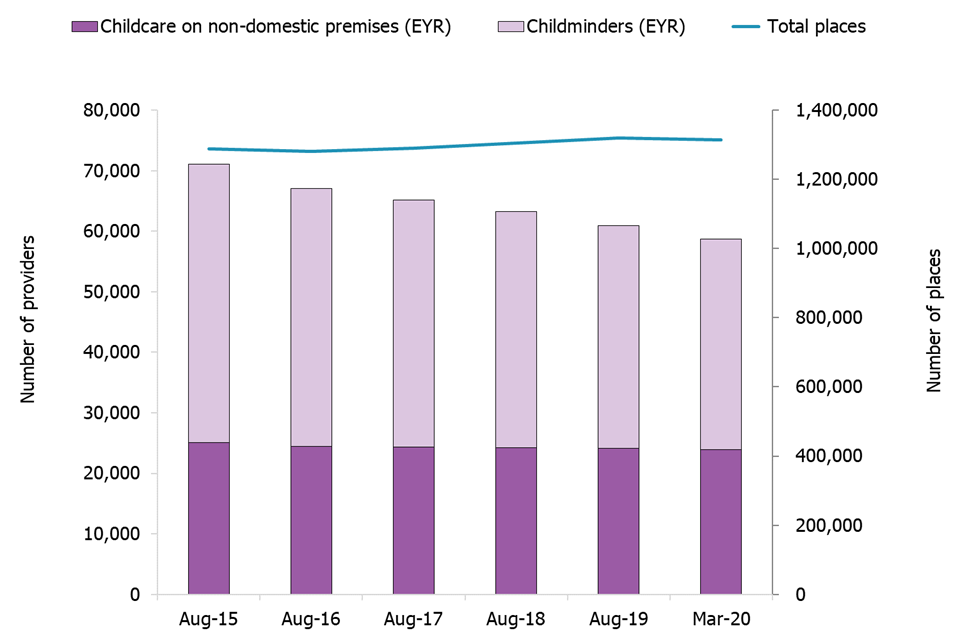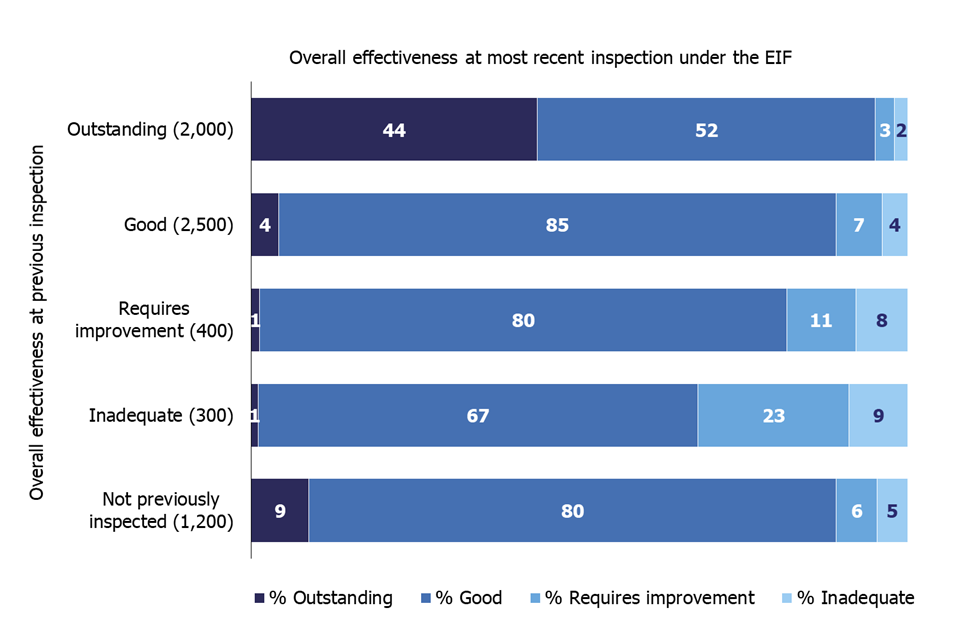Main findings: childcare providers and inspections as at 31 March 2020
Updated 26 August 2021
Applies to England
This is the main findings report for the childcare providers and inspections as at 31 March 2020 release. The following are also available:
- underlying data
- methodology
- pre-release access list
Summary
This release contains:
- the number of Ofsted-registered childcare providers and places and their most recent inspection outcomes on 31 March 2020
- the number of providers that have registered with Ofsted (joiners) and the number that have left (leavers) between 31 December 2019 and 31 March 2020
Despite the ongoing decline in the number of childminders, the number of places on the Early Years Register (EYR) has remained broadly stable since August 2015.
Compared to the same reporting period last year, fewer childminders have left and more have joined the registers. As a result, the overall decline in the number of childminders has slowed.
The proportion of providers judged good or outstanding at their most recent inspection has remained unchanged (96%). However, there has been a slight shift to a higher proportion of providers judged good and a lower proportion of outstanding since December 2019.
Over three quarters of the providers that were previously judged requires improvement or inadequate improved to good or outstanding between 1 September 2019 and 31 March 2020.
Figure 1: Overall effectiveness of active early years registered providers at their most recent inspection over time

Note: percentages are rounded and may not sum to 100.
Introduction
The early years and childcare sector is primarily made up of private nurseries, pre-schools and childminders. There are 4 types of early years provision:
Childcare on non-domestic premises
These are nurseries, pre-schools, holiday clubs and other group-based settings, usually registered on the EYR because they look after children aged 0 to 5.
Childminders
These are people who look after one or more children who they are not related to for payment or reward. The care takes place in a home that is not the child’s own. The majority register on the EYR because they look after children aged 0 to 5, but those who look after 5- to 7-year-olds need to register on the Childcare Register (CR).
Childcare on domestic premises
These are providers where 4 or more people look after children together in a home that is not the child’s. The majority are registered on the EYR and some are registered on the CR, depending on the age of the children they look after.
Home childcarers (nannies)
These are individuals who care for children aged 0 to 18 wholly or mainly in the child’s own home. They are not required to register with Ofsted, though they may choose to do so on the voluntary part of the Childcare Register (VCR).
Further information about provider types is available in the glossary.
Childminders have the option to either register with Ofsted or a childminder agency. Childminder agencies have the responsibility of inspecting the childminders registered with them. More information about childminder agencies is provided in the childminder agencies section.
Childcare in early years also occurs in the schools sector. This takes place in state-funded schools and independent schools. Since May 2015, childcare on non-domestic premises that are part of a school are not required to register on the EYR if they are only looking after children aged 2 and over. For more information, see the early years provision in the schools sector section of this page.
Providers, registers and places
Number of providers
There were 75,100 childcare providers registered with Ofsted on 31 March 2020, down by less than 1% (500) since 31 December 2019.[footnote 1] Since 31 August 2015, the number of providers has fallen by 14% (12,000), although numbers have been falling over a much longer period. Most of this overall decrease is due to a substantial fall in the number of childminders.
Note: comparisons for data going back to 31 August 2012 can be found in our release for childcare providers and inspections as at 31 August 2018 and releases before this.
Figure 2: Childcare providers registered with Ofsted as at 31 March 2020, by provider type

Note: numbers are rounded to the nearest 100.
Childminders
There were 37,000 providers on 31 March 2020, down by 600 since 31 December 2019. This continues a downward trend, with 11,000 (23%) fewer providers than on 31 August 2015.
Childcare on non-domestic premises
There were 27,600 providers on 31 March 2020, up by 100 providers since 31 December 2019. Numbers are fairly stable over time, with no change since 31 August 2015.
Home childcarers
There were 10,200 providers on 31 March 2020, an increase of around 100 providers since 31 December 2019. Although the number of home childcarers has fluctuated over time, there are now 10% fewer than there were on 31 August 2015.
Childcare on domestic premises
There were 200 providers on 31 March 2020. This has remained unchanged since the last release.
Childminder joiners and leavers over time
The decline in the number of childminders is due to a trend of more providers leaving than joining the childcare sector (see Figure 3).
Figure 3: Childminder joiners and leavers within successive January to March periods

Note: data refers to childminder joiners and leavers between 1 January and 31 March in each year.
Since the previous official statistics (31 December 2019), 1,300 childminders have left the childcare sector and 700 joined – a net decrease of 600. The childminders who left during this period had been registered for over 10 years on average (based on the assumption that the exact date they left the register was 31 March 2020).
Note: most leavers are provider resignations and most joiners are new provider registrations, but some will be providers moving between the EYR and the CR.
The number of leavers within successive January to March periods has slowly decreased over the past 5 years. Although the number of joiners has fluctuated since 2016, it has increased by over 100 since last year. Overall, compared with the same reporting period last year, the number of leavers has decreased and the number of joiners has increased. As a result, the overall decline in the number of childminders has slowed.
The North East had the lowest percentage decrease (0.6%) in the number of childminders, down by 9 during the current reporting period. The region with the highest percentage decrease (2.4%) was the West Midlands, with 70 fewer childminders since 31 August 2019.
Registers
On 31 March 2020, 79% (59,000) of Ofsted-registered childcare providers were on the EYR (see Figure 4). The remaining 21% were not on the EYR and so only appeared on the VCR and/or the compulsory part of the Childcare Register (CCR). More information about the different register types is available in the glossary.
Figure 4: Venn diagram of Ofsted-registered providers by the different registers for childcare

Note: numbers are rounded to the nearest 100.
Places data is reported for the 59,000 providers registered on the EYR, with a high proportion of these (89%) also being registered on the CR.
When considering places data, it is important to note that it covers all places for children up to the age of 8 in providers registered on the EYR. This encompasses all EYR places for children under 5 and CCR places for 5- to 7-year-olds in these providers. For more methodological notes on places data, see the methodology and quality report that accompanies this release.
Places
Figure 5: Number of childcare places offered by providers on the EYR, by provider type

Note: places numbers of less than one million are rounded to the nearest hundred. Places numbers of more than one million are rounded to the nearest 100,000.
Childminders
Childminders offered 17% (227,100) of all places, a decrease of 3 percentage points since August 2015. The average number of places offered by childminders was 6.5.
Childcare on non-domestic premises
Providers on non-domestic premises offered 82% (1.1 million) of all childcare places, which is an increase of 3 percentage points since August 2015. On average, each provider offered 45 places.
Childcare on domestic premises
Providers on domestic premises offered less than 1% (5,400) of places. On average, each provider offered 22 places.
Despite decreasing numbers of childminders, the number of childcare places has remained broadly stable since August 2015 (see Figure 6). Childminder places decreased by 2% between December 2019 and March 2020. However, there was a slight increase in the number of places offered by childcare on non-domestic premises. This meant that the overall number of places increased by around 2,100 (less than 1%) since December 2019.[footnote 2] On 31 March 2020, there were 1.3 million childcare places offered by providers on the EYR.
Figure 6: Childcare providers and places on the EYR over time, by provider type

Note: places data from August 2018 onwards is recorded in an updated administrative system and captures slightly more childcare places than previously.
Inspection outcomes
Education inspection framework inspection outcomes (1 September 2019 to 31 March 2020)
Since the introduction of the education inspection framework (EIF) on 1 September 2019, we have carried out 6,500 full EYR inspections to March 2020. Of these, 89% resulted in an overall effectiveness judgement of good or outstanding. This represents an increase since the last academic year (86%).
Note: we paused our routine inspections in mid-March due to the impact of COVID-19.
Out of the active providers that we had previously inspected, 59% retained their overall effectiveness judgement, while 28% received a lower overall effectiveness judgement at their most recent inspection. The majority of these providers moved from outstanding to good. This contributed to the shift in the overall grade profile for early years providers at their most recent inspection. Over three quarters of the providers that were previously judged requires improvement or inadequate improved to good or outstanding under the EIF (see Figure 7).
Figure 7: Overall effectiveness of providers at their most recent inspection under the EIF, by their previous inspection

Note: percentages are rounded and may not sum to 100.
Most recent inspections of providers on the EYR
On 31 March 2020, 44,800 eligible providers on the EYR had received a full inspection. The majority of the eligible providers that have not yet been inspected joined the EYR within the last 2 years.
At their most recent inspection, 96% of childcare providers on the EYR were judged either good or outstanding. This represents a substantial increase from 31 August 2015, when the proportion was 85% (see Figure 1).
Compared with 31 December 2019, the overall proportion of good or outstanding providers remains unchanged. However, a slightly higher proportion of providers were judged good (79%) and a lower proportion were judged outstanding (18%). This may be due to the selective way in which we carry out inspections, with weaker providers being inspected at the start of a 4-year cycle. As we approach the end of the inspection cycle (31 July 2020), we have inspected a higher proportion of outstanding providers in the current reporting period (42%) compared with the previous. We had not inspected these providers for over 4 years on average.
Note: a small proportion of providers may have only received a no children on roll (NCOR) inspection. These are excluded from the total number of providers on the EYR that have received an inspection. We have also excluded providers that, under the EIF, are now classed as out-of-school day care providers but may have previously had a full EYR inspection.
Childcare on non-domestic premises
At their most recent inspection, 97% were judged good or outstanding, unchanged since 31 December 2019. This was made up of 75% of providers judged good and 22% outstanding.
Over time, the proportion of childcare on non-domestic premises judged good or outstanding has increased. Part of this increase can be attributed to the fact that all childcare on non-domestic premises with a judgement of requires improvement must be re-inspected within 12 months. This means that non-domestic providers have the opportunity to demonstrate improvement sooner.
Childminders
At their most recent inspection, 96% were judged good or outstanding, up by 1 percentage point since the end of December 2019. This was made up of 81% of providers judged good and 15% judged outstanding.
Since the beginning of August 2016, we have prioritised inspections for childminders who had previously received a judgement of requires improvement or inadequate. On 31 March 2020, 92% of childminders who were previously judged requires improvement or inadequate, improved to good or outstanding at their most recent inspection.
The quality of those leaving the sector may have also contributed to the rise in the proportion of providers judged good or outstanding. Providers leaving the sector are more likely to have been judged requires improvement or inadequate at their most recent inspection, than those that remain. Of the providers inspected since September 2015 who then left the sector, 16% had received a judgement of requires improvement or inadequate at their most recent EYR inspection, compared with only 4% of all active providers.
Regional inspection outcomes
On 31 March 2020, all regions had fairly similar proportions of providers judged good or outstanding. The East of England and the South West had the highest proportion of providers judged outstanding (20%) and the East Midlands had the lowest (14%).
There was a higher or equal proportion of non-domestic providers judged good or outstanding compared with childminders in all regions. London had the largest difference between non-domestic providers (98%) and childminders (94%) judged good or outstanding.
On a national level, the difference in the proportion of non-domestic providers judged outstanding (22%) compared with childminders (15%) was notably more pronounced. There was also a wide variation in the difference between the proportion of outstanding childminders and non-domestic providers across the regions (see Figure 8).
Figure 8 : Percentage of childminders and non-domestic providers judged outstanding on 31 March 2020, by region

You can find additional information on local authorities and Parliamentary constituencies in the provider-level data file accompanying this release.
Childminder agencies
Childminder agencies were introduced in September 2014, enabling new childminders to choose to register with Ofsted directly or register with an agency. Existing childminders could also choose to de-register with Ofsted and register instead with a childminder agency. Childminder agencies have the responsibility of inspecting the childminders who are registered with them, with Ofsted inspecting the childminder agencies.
Childminder agencies are only eligible for inspection when they have childminders on roll. There are only 2 overall effectiveness inspection outcomes: ‘effective’ and ‘ineffective’. On 31 March 2020, 12 childminder agencies were registered with Ofsted. Of these, 7 had childminders on roll and were therefore eligible for inspection. Of the 7 childminder agencies, we have inspected 5 to date and all have been judged ‘effective’.
Data for childminder agencies is available in the provider-level data file accompanying this release.
Early years provision in the schools sector
Early years provision also occurs in the schools sector. This takes place in state-funded schools. If nurseries within schools are only looking after children aged 2 and over, they are exempt from registration on the EYR. Nurseries looking after children aged younger than 2 are still required to register on the EYR and are therefore covered in the previous sections.
In state-funded schools, other than nursery schools, early years provision is given its own judgement as part of the overall inspection of the school. On 31 March 2020, there were around 10,700 state-funded schools with an early years judgement at their most recent school inspection. Of these, 82% were judged good or outstanding on the overall effectiveness of the school and 88% were judged to be good or outstanding for early years provision.
There are several reasons why schools that received an early years judgement may not be representative of all schools with early years provision. For instance, we did not provide separate graded judgements on the overall effectiveness of early years between January 2012 and August 2014. Furthermore, short inspections will confirm whether the overall effectiveness is good or outstanding but will not provide or update a previous early years provision judgement.
On 31 March 2020, there were 389 state-funded nursery schools in England. We have inspected all of these and 98% received a grade of good or outstanding at their most recent inspection (see Table 1). This was made up of a very large proportion (63%) of nursery schools judged outstanding and 35% judged good.
Table 1: Overall effectiveness of open state-funded nursery schools on 31 March 2020
| All inspected nursery schools | Outstanding | Good | Requires improvement | Inadequate | |
|---|---|---|---|---|---|
| Number of nursery schools inspected | 389 | 247 | 136 | 5 | 1 |
| Percentage of inspected nursery schools | 100 | 63 | 35 | 1 | 0 |
For more information on school inspections and outcomes, you should refer to our management information on state-funded schools inspections and outcomes.
Many independent schools also provide nursery provision. On 31 March 2020, there were 242 non-association independent schools with an early years judgement at their most recent standard inspection. Of these, 77% were judged good or outstanding on their early years provision. For more information on non-association independent schools inspections and outcomes, see our statistics on non-association independent schools.
Ofsted only inspects non-association independent schools. The Independent Schools Inspectorate (ISI) inspects association independent schools.
Notes
An explanation about main uses of this data, further contextual information and the arrangements for quality assurance is provided in the methodology and quality report accompanying this release.
The methodology and quality report also provides information on the strengths and limitations of the statistics.
Revisions to previous release
The provisional data in the previous release related to inspections that took place between 1 September 2019 and 31 December 2019 and were published by 31 January 2020. A revised list of inspections in this period is provided in Tables 14 to 19 of the ‘Childcare providers and inspections charts and tables’ document for this release. This revised data includes 12 inspections that were published by 30 April 2020 (that were not published by 31 January 2020).
These revisions did not result in any changes to the main findings identified in the previous publication.
We publish revisions to data in this publication in line with our revisions policy for official statistics.
Education inspection framework
We carried out inspections from 1 September 2019 under the EIF. The EIF supports consistency when carrying out inspections of early years and childcare providers, maintained schools, academies, non-association independent schools, and further education and skills providers in England. We evaluate the overall quality and standards of the early years provision in line with the principles and requirements of the early years foundation stage (EYFS) statutory framework. Inspectors judge the overall effectiveness of the early years provision, taking into account 4 judgements:
- quality of education
- behaviour and attitudes
- personal development
- effectiveness of leadership and management
We are required to inspect all providers that were on the EYR on 1 August 2016 at least once by 31 July 2020. We will normally inspect providers that have registered after this date within 30 months of registration.
Common inspection framework
Between 1 September 2015 and 31 August 2019, we carried out inspections under the common inspection framework. Inspectors judged the overall effectiveness of the early years provision, taking into account the following judgements:
- quality of teaching, learning and assessment
- personal development, behaviour and welfare
- effectiveness of leadership and management
- outcomes for children
Glossary
Definitions of terms are within the statistical glossary
Further information
We publish the following information on the inspection of early years providers:
- early years and childcare statistics
- education inspection framework
- framework for the regulation of provision on the childcare register
Contact for comments or feedback
If you have any comments or feedback on this publication, you should contact Anita Patel on 03000 130 914 or Anita.Patel@ofsted.gov.uk.
Acknowledgements
Thanks to the following for their contribution to this statistical release: Giada Maugeri, Lucy Conway, Richard Smith and Alison Bateman.
Instructions for printing and saving
Instructions may vary depending on which browser you use, such as Internet Explorer or Google Chrome, and the type of device you use, such as an iPhone or laptop.
You will find your print and save options in your browser’s menu. You may also have other options available on your device. The instructions for mobile and tablet devices will be specific to their make and model.
How to search
Click on Ctrl + F on a Windows laptop or Command + F on a Mac
This will open a search box in the top right-hand corner of the page. Type the word you are looking for in the search bar and press enter.
Your browser will highlight the word, usually in yellow, wherever it appears on the page. Press enter to move to the next place it appears.
How to print a copy of the guidance
Click on Ctrl + P on a Windows laptop or Command + P on a Mac
You can also choose to save as a PDF.

